RabbitMQ介绍
1.1.引言
你是否遇到过两个(多个)系统间需要通过定时任务来同步某些数据?你是否在为异构系统的不同进程间相互调用、通讯的问题而苦恼、挣扎?消息服务让你可以很轻松地解决这些问题。
消息服务擅长于解决多系统、异构系统间的数据交换(消息通知/通讯)问题,你也可以把它用于系统间服务的相互调用(RPC)。模块之间的耦合度高,导致一个模块宕机后,全部功能不能用了,并且同步通信成本高,用户体验差。
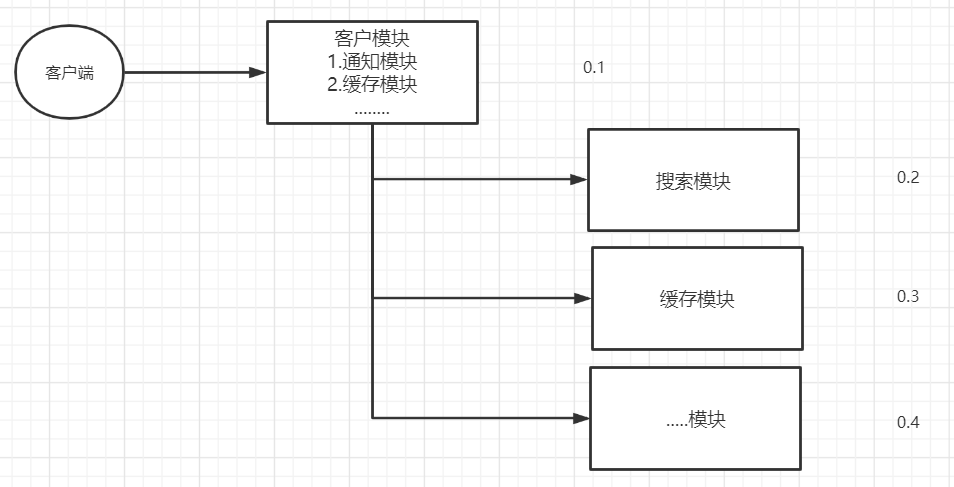
1.2.RabbitMQ介绍
市面上比较火爆的几款MQ:
ActiveMQ、RocketMQ、Kafka、RabbitMQ
- 语言的支持:ActiveMQ、RocketMQ只支持Java语言,Kafka、RabbitMQ支持多种语言。
- 效率方面:ActiveMQ、RocketMQ、Kafka效率都是毫秒级别,RabbitMQ是微秒级别的。
- 消息丢失,消息重复问题:RabbitMQ针对消息的持久化,和重复问题都有比较成熟的解决方案。
- 学习成本:RabbitMQ非常简单。
RabbitMQ是由Rabbit公司去研发和维护的,最终是在Pivotal。
RabbitMQ严格的遵循AMQP协议,高级消息队列协议,帮助我们在进程之间传递异步消息。
RabbitMQ安装
Windows安装
1.安装
Erlang=》2.安装RabbitMQ=》3.激活RabbitMQ's Management Plugin可视化插件RabbitMQ是采用Erlang语言开发的,所以系统环境必须提供Erlang环境
Erlang和RabbitMQ版本的按照比较: https://www.rabbitmq.com/which-erlang.html
1、安装Erlang

- 下载地址:https://www.erlang.org/downloads,选择`OTP 23.2 Windows 64-bit Binary File`
- 运行
otp_win64_23.2.exe,安装Erlang(默认next 和 install 即可) - 设置环境变量:
- ERLANG_HOME:D:\xx\erl-23.2(erlang安装路径)
- Path追加:;%ERLANG_HOME%\bin
- 打开CMD输入
erl, 提示版本信息:Eshell V11.1.4 (abort with ^G), 说明安装成功
2、安装RabbitMQ
- 下载地址: https://www.rabbitmq.com/install-windows.html,选择`rabbitmq-server-3.8.14.exe`
- 历史版本下载地址:https://github.com/rabbitmq/rabbitmq-server/releases
- 运行
rabbitmq-server-3.8.14.exe,安装RabbitMQ - 设置环境变量:
- RABBITMQ_SERVER:D:\rabbitmq\rabbitmq-server-3.8.14(安装路径)
- Path追加:;%RABBITMQ_SERVER%\sbin
- 命令行输入:rabbitmqctl status, 出现如下信息说明安装成功并且启动
D:\Environment\RabbitMQ Server\rabbitmq_server-3.8.14\sbin>rabbitmqctl status
Status of node rabbit@LAPTOP-671C76TJ ...
[1mRuntime[0m
OS PID: 7916
OS: Windows
Uptime (seconds): 2291
Is under maintenance?: false
RabbitMQ version: 3.8.14
Node name: rabbit@LAPTOP-671C76TJ
Erlang configuration: Erlang/OTP 23 [erts-11.1.4] [source] [64-bit] [smp:8:8] [ds:8:8:10] [async-threads:1]
Erlang processes: 473 used, 1048576 limit
Scheduler run queue: 1
Cluster heartbeat timeout (net_ticktime): 60
[1mPlugins[0m
Enabled plugin file: c:/Users/lenovo/AppData/Roaming/RabbitMQ/enabled_plugins
Enabled plugins:
* rabbitmq_management
* amqp_client
* rabbitmq_web_dispatch
* cowboy
* cowlib
* rabbitmq_management_agent
[1mData directory[0m
Node data directory: c:/Users/lenovo/AppData/Roaming/RabbitMQ/db/rabbit@LAPTOP-671C76TJ-mnesia
Raft data directory: c:/Users/lenovo/AppData/Roaming/RabbitMQ/db/rabbit@LAPTOP-671C76TJ-mnesia/quorum/rabbit@LAPTOP-671C76TJ
[1mConfig files[0m
* c:/Users/lenovo/AppData/Roaming/RabbitMQ/advanced.config
[1mLog file(s)[0m
* c:/Users/lenovo/AppData/Roaming/RabbitMQ/log/rabbit@LAPTOP-671C76TJ.log
* c:/Users/lenovo/AppData/Roaming/RabbitMQ/log/rabbit@LAPTOP-671C76TJ_upgrade.log
[1mAlarms[0m
(none)
[1mMemory[0m
Total memory used: 0.1347 gb
Calculation strategy: rss
Memory high watermark setting: 0.4 of available memory, computed to: 6.8184 gb
allocated_unused: 0.0386 gb (28.69 %)
code: 0.0328 gb (24.35 %)
other_proc: 0.0319 gb (23.69 %)
other_system: 0.0162 gb (12.05 %)
plugins: 0.0059 gb (4.38 %)
other_ets: 0.0036 gb (2.65 %)
reserved_unallocated: 0.0031 gb (2.34 %)
atom: 0.0015 gb (1.08 %)
binary: 0.0004 gb (0.33 %)
metrics: 0.0002 gb (0.17 %)
mgmt_db: 0.0002 gb (0.13 %)
mnesia: 0.0001 gb (0.07 %)
quorum_ets: 0.0 gb (0.04 %)
msg_index: 0.0 gb (0.02 %)
connection_other: 0.0 gb (0.0 %)
connection_channels: 0.0 gb (0.0 %)
connection_readers: 0.0 gb (0.0 %)
connection_writers: 0.0 gb (0.0 %)
queue_procs: 0.0 gb (0.0 %)
queue_slave_procs: 0.0 gb (0.0 %)
quorum_queue_procs: 0.0 gb (0.0 %)
[1mFile Descriptors[0m
Total: 2, limit: 65439
Sockets: 0, limit: 58893
[1mFree Disk Space[0m
Low free disk space watermark: 0.05 gb
Free disk space: 93.5777 gb
[1mTotals[0m
Connection count: 0
Queue count: 0
Virtual host count: 1
[1mListeners[0m
Interface: [::], port: 25672, protocol: clustering, purpose: inter-node and CLI tool communication
Interface: [::], port: 5672, protocol: amqp, purpose: AMQP 0-9-1 and AMQP 1.0
Interface: 0.0.0.0, port: 5672, protocol: amqp, purpose: AMQP 0-9-1 and AMQP 1.0
Interface: [::], port: 15672, protocol: http, purpose: HTTP API
Interface: 0.0.0.0, port: 15672, protocol: http, purpose: HTTP API
3、激活RabbitMQ’s Management Plugin可视化插件
- 进入RabbitMQ安装的/sbin目录下输入安装命令:rabbitmq-plugins enable rabbitmq_management
- 出现如下信息表示成功(可以通过查看所有插件查看是否成功:rabbitmq-plugins list)
D:\Environment\RabbitMQ Server\rabbitmq_server-3.8.14\sbin>rabbitmq-plugins enable rabbitmq_management
Enabling plugins on node rabbit@LAPTOP-671C76TJ:
rabbitmq_management
The following plugins have been configured:
rabbitmq_management
rabbitmq_management_agent
rabbitmq_web_dispatch
Applying plugin configuration to rabbit@LAPTOP-671C76TJ...
The following plugins have been enabled:
rabbitmq_management
rabbitmq_management_agent
rabbitmq_web_dispatch
started 3 plugins.
4、如上是通过*.exe方式安装的,所以自动帮我们安装好了服务启动和服务暂时删除等

5、如何是通过*.zip文件安装的话需要手动安装RabbitMQ服务
1、以应用方式启动(如何没有install安装成windows服务)
- 前台启动:rabbitmq-server
- 后台启动:rabbitmq-server -detached
2、Rabbitmq服务的启动和关闭:(以服务方式启动)
- 启动服务:rabbitmq-service start
- 重启服务:rabbitmq-service restart
- 停止服务:rabbitmq-service stop
- 安装服务:rabbitmq-service install
- 删除服务:rabbitmq-service remove
- 使服务有效:rabbitmq-service enable
- 使服务无效:rabbitmq-service disable
- 查看帮助:rabbitmq-service help
当rabbitmq-service install之后默认服务是enable的,如果这时设置服务为disable的话,rabbitmq-service start就会报错。
当rabbitmq-service start正常启动服务之后,使用disable是没有效果的
Rabbitmq插件的启用和关闭
查看插件列表:rabbitmq-plugins list(标记为E或e的已经启用的插件,没标记的为未启用插件)
启动某个插件:rabbitmq-plugins enable plugin-name
关闭某个插件:rabbitmq-plugins disable plugin-name
例如:rabbitmq_management,该插件为rabbitmq提供一个基于web管理界面,可以很方便的在浏览器中管理rabbitmq,登录地址默认为:localhost:15672,用户名和密码都为guest。
安装:rabbitmq-plugins enable/disable rabbitmq_management
Rabbitmq一个重要的管理平台rabbitmqctl:
它提供了各种对rabbitmq进行管理的各种命令,这里列举一些比较常用的
# 启动应用(在Erlang VM运行的情况下启动RabbitMQ应用):
rabbitmqctl start_app
# 关闭应用:
rabbitmqctl stop_app
# 查看节点状态
rabbitmqctl status
# 列出所有queue:
rabbitmqctl list_queues
# 列出指定queue的信息:
rabbitmqctl list_queues [the queue name] messages_ready messages_unacknowledged
# 列出所有exchange:
rabbitmqctl list_exchanges
# 列出所有binding:
rabbitmqctl list_bindings
# 查看用户列表:
rabbitmqctl list_users
# 创建用户:
rabbitmqctl add_user [username] [password]
rabbitmqctl add_user user_admin password
# 删除用户:
rabbitmqctl delete_user [username]
rabbitmqctl delete_user user_admin
# 修改密码:
rabbitmqctl change_password [username] [newpassword]
rabbitmqctl change_password user_admin 123456
# 使用命令给rabbit设置tag:none、management、policymaker、monitoring、administrator
rabbitmqctl set_user_tag username [tag1] [tag2] ...
rabbitmqctl set_user_tag user_admin administrator
# 列出虚拟主机上的所有权限:
rabbitmqctl list_permissions -p [vhostpath]
rabbitmqctl list_permissions -p /test
# 查看用户权限:
rabbitmqctl list_user_permissions [username]
rabbitmqctl list_user_permissions user_admin
# 设置用户权限:
rabbitmqctl set_permissions -p vhostpath username ".*" ".*" ".*"
rabbitmqctl set_permissions -p / user_admin ".*" ".*" ".*"
# 清除用户权限:
rabbitmqctl clear_permissions -p vhostpath username
rabbitmqctl clear_permissions -p / user_admin
# 列出所以虚拟主机:
rabbitmqctl list_vhosts
# 创建虚拟主机:
rabbitmqctl add_vhost [vhostpath]
rabbitmqctl add_vhost /test
# 删除虚拟主机:
rabbitmqctl delete_vhost [vhostpath]
rabbitmqctl delete_vhost /test
# 移除所有数据,要在 rabbitmqctl stop_app 之后使用:
rabbitmqctl reset
2、用户角色分类
用户角色可分为五类,超级管理员, 监控者, 策略制定者, 普通管理者以及其他。
(1) 超级管理员(administrator)
可登陆管理控制台(启用management plugin的情况下),可查看所有的信息,并且可以对用户,策略(policy)进行操作。
(2) 监控者(monitoring)
可登陆管理控制台(启用management plugin的情况下),同时可以查看rabbitmq节点的相关信息(进程数,内存使用情况,磁盘使用情况等)
(3) 策略制定者(policymaker)
可登陆管理控制台(启用management plugin的情况下), 同时可以对policy进行管理。但无法查看节点的相关信息
(4) 普通管理者(management)
仅可登陆管理控制台(启用management plugin的情况下),无法看到节点信息,也无法对策略进行管理。
(5) 其他
无法登陆管理控制台,通常就是普通的生产者和消费者。
3、用户权限
用户权限指的是用户对exchange,queue的操作权限,包括配置权限,读写权限。配置权限会影响到exchange,queue的声明和删除。读写权限影响到从queue里取消息,向exchange发送消息以及queue和exchange的绑定(bind)操作。
例如: 将queue绑定到某exchange上,需要具有queue的可写权限,以及exchange的可读权限;向exchange发送消息需要具有exchange的可写权限;从queue里取数据需要具有queue的可读权限。详细请参考官方文档中"How permissions work"部分。
(1) 设置用户权限
rabbitmqctl set_permissions -p VHostPath User ConfP WriteP ReadP
(2) 查看(指定hostpath)所有用户的权限信息
rabbitmqctl list_permissions [-p VHostPath]
(3) 查看指定用户的权限信息
rabbitmqctl list_user_permissions User
(4) 清除用户的权限信息
rabbitmqctl clear_permissions [-p VHostPath] User
有5个tag可供选择,分别是:administrator ,monitoring,policymaker,management和none 有兴趣的同学可以到这里了解各个tag的含义,其实这里的tag代表的是权限,administrator是最高权限,none表示不能访问,这里administrator和none的组合,权限应该是向高看齐,忽略none,用的是administrator的权限。我们用rabbit1/rabbit1 登录rabbitmq_management。
rabbitMQ启动成功后浏览器访问localhost:55672 默认账号:guest 密码:guest
Docker安装
version: "3.1"
services:
rabbitmq:
image: daocloud.io/library/rabbitmq:management
restart: always
container_name: rabbitmq
ports:
- 5672:5672
- 15672:15672
volumes:
- ./data:/var/lib/rabbitmq
# 创建目录
$ mkdir -p /usr/local/docker-compose/rabbitmq
# 编写docker-compose.yml文件
$ vi /usr/local/docker-compose/rabbitmq/docker-compose.yml
# 后台启动
$ docker-compose up -d
# rabbitmq web端默认关闭的,手动开启
$ docker exec -it rabbitmq rabbitmq-plugins enable rabbitmq_management
# 或者
$ docker-compose exec rabbitmq rabbitmq-plugins enable rabbitmq_management
RabbitMQ架构
3.1.官方的简单架构图
- Publisher - 生产者:发布消息到 RabbitMQ中的 Exchange
- Consumer - 消费者:监听 RabbitMQ中的 Queue中的消息
- Exchange - 交换机:和生产者建立连接并接收生产者的消息
- Queue - 队列:Exchange会将消息分发到指定的 Queue, Queue和消费者进行交互
- Routes - 路由:交换机以什么样的策略将消息发布到 Queue
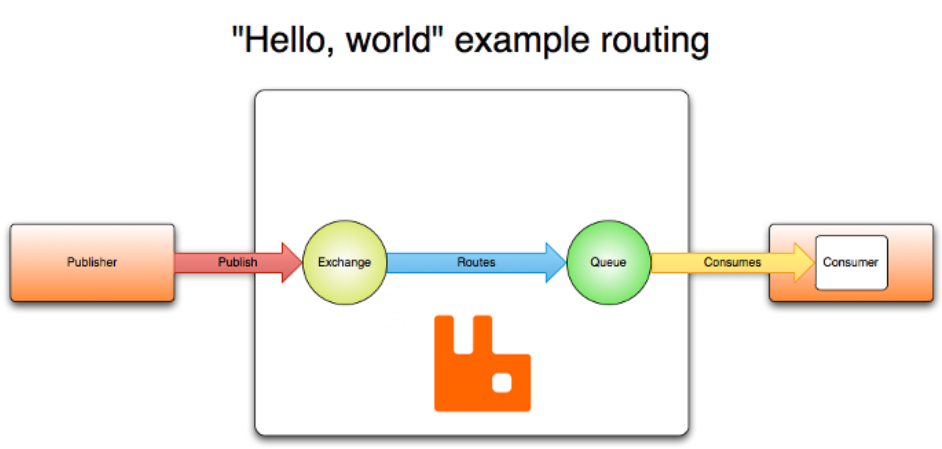
3.2.RabbitMQ完整架构图
3.3.图形界面创建User和VHost
1.创建User:账号/密码为 test/test
2.创建Virtual Host:/test
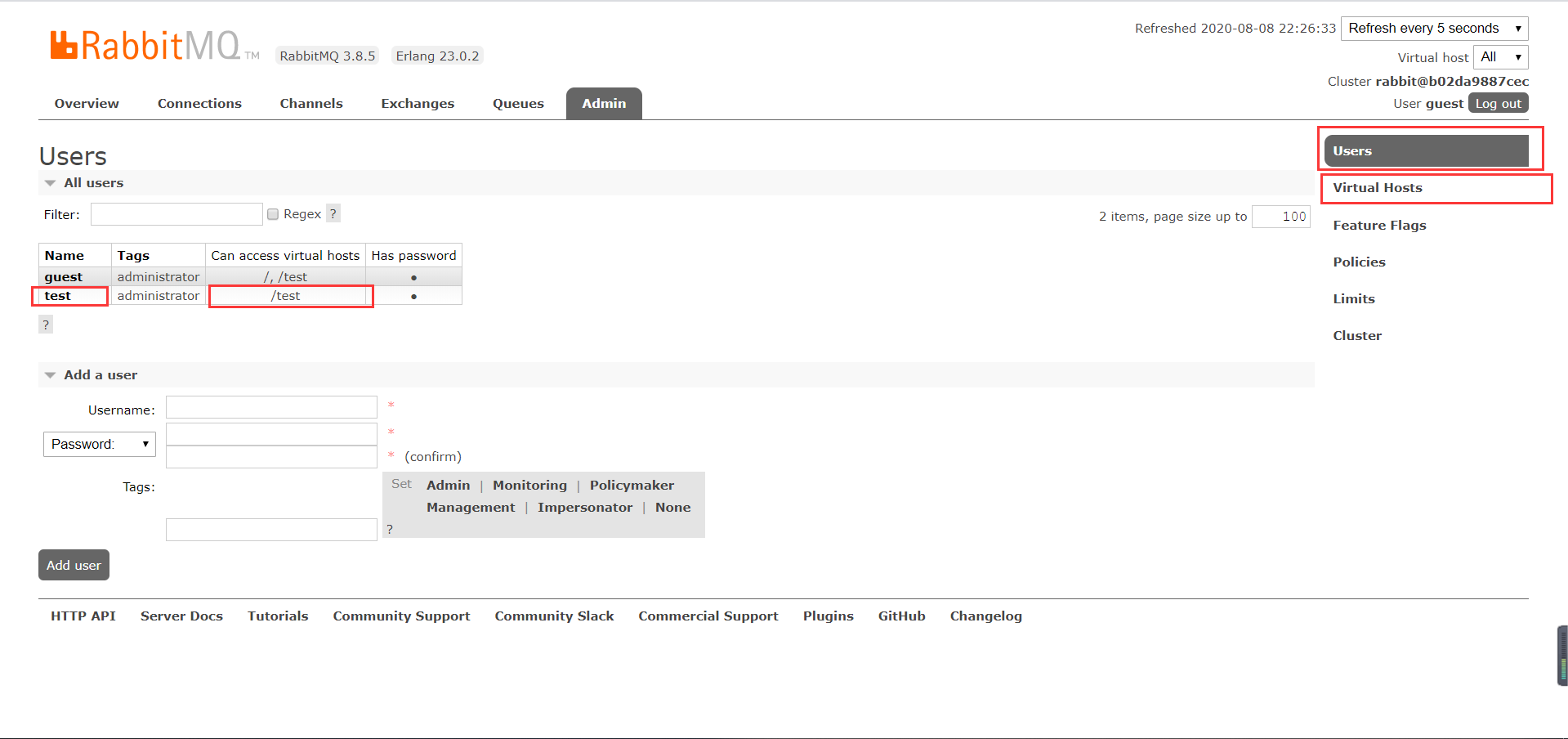
RabbitMQ的使用
4.1.RabbitMQ的通讯方式
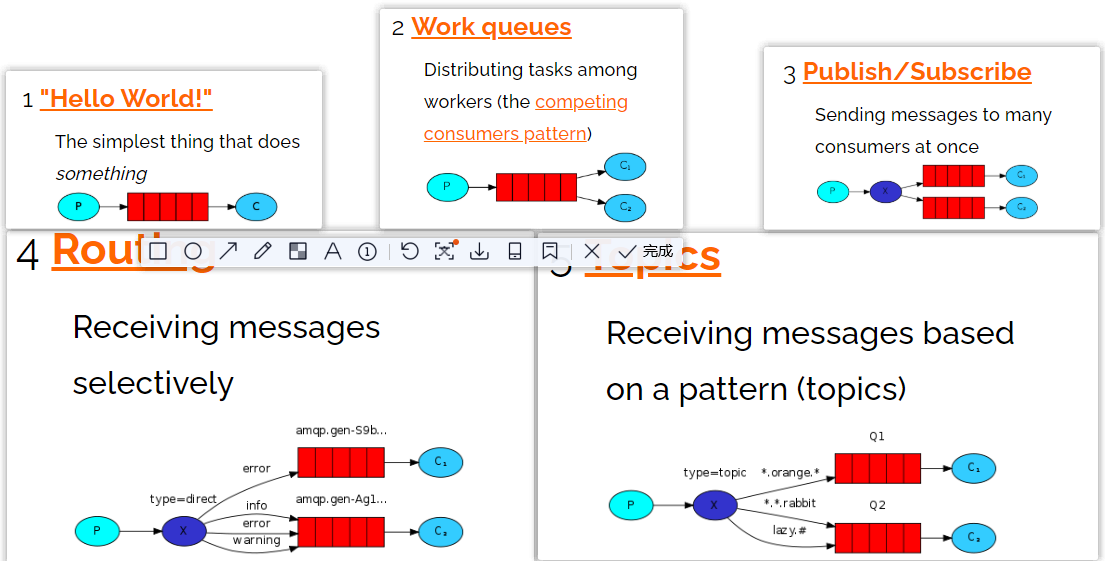
4.2.Java连接RabbitMQ
1.创建maven项目
2.导入依赖
<dependencies>
<dependency>
<groupId>com.rabbitmq</groupId>
<artifactId>amqp-client</artifactId>
<version>5.6.0</version>
</dependency>
<dependency>
<groupId>junit</groupId>
<artifactId>junit</artifactId>
<version>4.12</version>
</dependency>
</dependencies>
3.创建工具类连接RabbitMQ
package com.liusx.config;
import com.rabbitmq.client.Connection;
import com.rabbitmq.client.ConnectionFactory;
import org.junit.Test;
import java.io.IOException;
public class RabbitMQClient {
public static Connection getConnection(){
ConnectionFactory connectionFactory = new ConnectionFactory();
connectionFactory.setHost("192.168.3.54");
connectionFactory.setPort(5672);
connectionFactory.setUsername("test");
connectionFactory.setPassword("test");
connectionFactory.setVirtualHost("/test");
Connection connection = null;
try {
connection = connectionFactory.newConnection();
} catch (Exception e) {
e.printStackTrace();
}
return connection;
}
@Test
public void getConnectionTest() throws IOException {
Connection connection = RabbitMQClient.getConnection();
//connection.close();
}
}

4.3.Hello-World
一个生产者,一个默认的交换机,一个队列,一个消费者
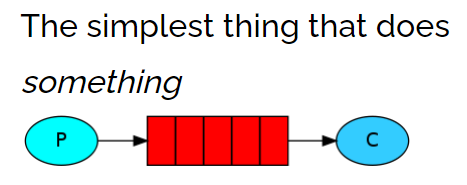
创建生产者,创建一个channel,发布消息到exchange,指定路由规则
package com.liusx.com.liusx.helloworld;
import com.liusx.config.RabbitMQClient;
import com.rabbitmq.client.Channel;
import com.rabbitmq.client.Connection;
import org.junit.Test;
public class Publisher {
@Test
public void publish() throws Exception {
//1. 获取Connection
Connection connection = RabbitMQClient.getConnection();
//2. 创建Channel
Channel channel = connection.createChannel();
//3. 发布消息到exchange,同时指定路由的规则
String msg = "Hello-World!";
// 参数1:指定exchange,使用""。
// 参数2:指定路由的规则,使用具体的队列名称。
// 参数3:指定传递的消息所携带的properties,使用null。
// 参数4:指定发布的具体消息,byte[]类型
channel.basicPublish("","HelloWorld",null,msg.getBytes());
// Ps:exchange是不会帮你将消息持久化到本地的,Queue才会帮你持久化消息。
System.out.println("生产者发布消息成功!");
//4. 释放资源
channel.close();
connection.close();
}
}
创建消费者,创建一个channel,创建一个队列,并且去消费当前队列
package com.liusx.com.liusx.helloworld;
import com.liusx.config.RabbitMQClient;
import com.rabbitmq.client.*;
import org.junit.Test;
import java.io.IOException;
public class Consumer {
@Test
public void consume() throws Exception {
//1. 获取连接对象
Connection connection = RabbitMQClient.getConnection();
//2. 创建channel
Channel channel = connection.createChannel();
//3. 声明队列-HelloWorld
//参数1:queue - 指定队列的名称
//参数2:durable - 当前队列是否需要持久化(true)
//参数3:exclusive - 是否排外(conn.close() - 当前队列会被自动删除,当前队列只能被一个消费者消费)
//参数4:autoDelete - 如果这个队列没有消费者在消费,队列自动删除
//参数5:arguments - 指定当前队列的其他信息
channel.queueDeclare("HelloWorld",true,false,false,null);
//4. 开启监听Queue
DefaultConsumer consume = new DefaultConsumer(channel){
@Override
public void handleDelivery(String consumerTag, Envelope envelope, AMQP.BasicProperties properties, byte[] body) throws IOException {
System.out.println("接收到信息:"+new String(body,"UTF-8"));
}
};
//5. 消费
//参数1:queue - 指定消费哪个队列
//参数2:autoAck - 指定是否自动ACK (true,接收到消息后,会立即告诉RabbitMQ)
//参数3:consumer - 指定消费回调
channel.basicConsume("HelloWorld",false,consume);
System.out.println("消费者开始监听队列!");
// 让程序停止,好接收消费
System.in.read();
//5. 释放资源
channel.close();
connection.close();
}
}
4.4.Work
一个生产者,一个默认的交换机,一个队列,两个消费者
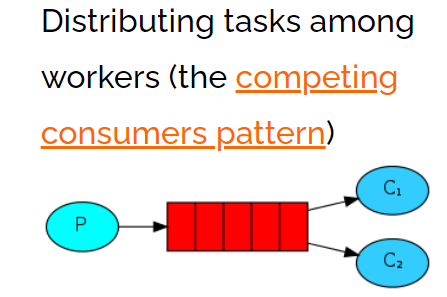
只需要在消费端,添加Qos能力以及更改为手动ack即可让消费者,根据自己的能力去消费指定的消息,而不是默认情况下由RabbitMQ平均分配,生产者不变,正常发布消息默认的exchange,并指定routing
消费者指定Qoa和手动ack
修改生产者代码,循环发送消息
package com.liusx.work;
import com.liusx.config.RabbitMQClient;
import com.rabbitmq.client.Channel;
import com.rabbitmq.client.Connection;
import org.junit.Test;
public class Publisher {
@Test
public void publish() throws Exception {
//1. 获取Connection
Connection connection = RabbitMQClient.getConnection();
//2. 创建Channel
Channel channel = connection.createChannel();
//3. 发布消息到exchange,同时指定路由的规则
for (int i = 0; i < 10 ; i++) {
String msg = "Hello-World!" + i;
channel.basicPublish("","Work",null,msg.getBytes());
}
System.out.println("生产者发布消息成功!");
//4. 释放资源
channel.close();
connection.close();
}
}
创建2个消费者:Qoa和休眠可以修改消费者不以平均消费消息
package com.liusx.work;
import com.liusx.config.RabbitMQClient;
import com.rabbitmq.client.*;
import org.junit.Test;
import java.io.IOException;
public class Consumer1 {
@Test
public void consume() throws Exception {
//1. 获取连接对象
Connection connection = RabbitMQClient.getConnection();
//2. 创建channel
Channel channel = connection.createChannel();
//3. 声明队列-HelloWorld
channel.queueDeclare("Work",true,false,false,null);
//3.5 指定当前消费者,一次消费多少个消息
channel.basicQos(1);
//4. 开启监听Queue
DefaultConsumer consumer = new DefaultConsumer(channel){
@Override
public void handleDelivery(String consumerTag, Envelope envelope, AMQP.BasicProperties properties, byte[] body) throws IOException {
try {
//Thread.sleep(100);
} catch (Exception e) {
e.printStackTrace();
}
System.out.println("消费者1号接收到消息:" + new String(body,"UTF-8"));
// 手动ack
//参数2:是否批量操作
channel.basicAck(envelope.getDeliveryTag(),false);
}
};
channel.basicConsume("Work",false,consumer);
System.out.println("开始消费消息。。。。");
System.in.read();
//5. 释放资源
channel.close();
connection.close();
}
}
package com.liusx.work;
import com.liusx.config.RabbitMQClient;
import com.rabbitmq.client.*;
import org.junit.Test;
import java.io.IOException;
public class Consumer2 {
@Test
public void consume() throws Exception {
//1. 获取连接对象
Connection connection = RabbitMQClient.getConnection();
//2. 创建channel
Channel channel = connection.createChannel();
//3. 声明队列-HelloWorld
channel.queueDeclare("Work",true,false,false,null);
//3.5 指定当前消费者,一次消费多少个消息
channel.basicQos(2);
//4. 开启监听Queue
DefaultConsumer consumer = new DefaultConsumer(channel){
@Override
public void handleDelivery(String consumerTag, Envelope envelope, AMQP.BasicProperties properties, byte[] body) throws IOException {
try {
//Thread.sleep(200);
} catch (Exception e) {
e.printStackTrace();
}
System.out.println("消费者2号接收到消息:" + new String(body,"UTF-8"));
// 手动ack
channel.basicAck(envelope.getDeliveryTag(),false);
}
};
channel.basicConsume("Work",false,consumer);
System.out.println("开始消费消息。。。。");
// System.in.read();
System.in.read();
//5. 释放资源
channel.close();
connection.close();
}
}
4.5.Public/Subscribe
一个生产者,一个交换机,两个队列,两个消费者
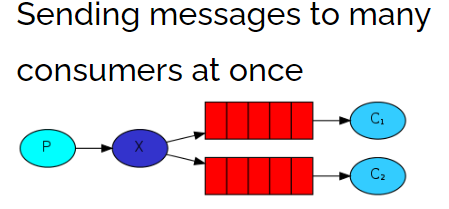
声明一个Fanout类型的exchange,并且将exchange和queue绑定一起,绑定的方式就是直接绑定
让生产者创建一个exchange并且指定类型,和一个或多个队列绑定到一起
package com.liusx.pubsub;
import com.liusx.config.RabbitMQClient;
import com.rabbitmq.client.BuiltinExchangeType;
import com.rabbitmq.client.Channel;
import com.rabbitmq.client.Connection;
import org.junit.Test;
public class Publisher {
@Test
public void publish() throws Exception {
//1. 获取Connection
Connection connection = RabbitMQClient.getConnection();
//2. 创建Channel
Channel channel = connection.createChannel();
//3. 创建exchange - 绑定某一个队列
//参数1: exchange的名称
//参数2: 指定exchange的类型:FANOUT-pubsub、DIRECT-Routing、TOPIC-Topics
channel.exchangeDeclare("pubsub-exchange", BuiltinExchangeType.FANOUT);
channel.queueBind("pubsub-queue1","pubsub-exchange","");
channel.queueBind("pubsub-queue2","pubsub-exchange","");
//4. 发布消息到exchange,同时指定路由的规则
for (int i = 0; i < 10 ; i++) {
String msg = "Hello-World!" + i;
channel.basicPublish("pubsub-exchange","",null,msg.getBytes());
}
System.out.println("生产者发布消息成功!");
//5. 释放资源
channel.close();
connection.close();
}
}
消费这还是与上一节一样,修改队列名称即可
//3. 声明队列-HelloWorld
channel.queueDeclare("pubsub-queue1",true,false,false,null);
//4. 开启监听Queue,然后消费
channel.basicConsume("pubsub-queue1",false,consumer);
--------------
//3. 声明队列-HelloWorld
channel.queueDeclare("pubsub-queue2",true,false,false,null);
//4. 开启监听Queue,然后消费
channel.basicConsume("pubsub-queue2",false,consumer);
4.6.Routing
一个生产者,一个交换机,两个队列,两个消费者
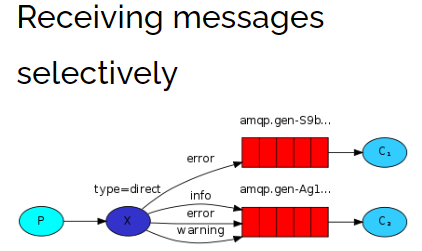
生产者在创建DIRECT类型的exchange后,根据RoutingKey去绑定相应的队列,并且在发送消息时,指定消息的具体RoutingKey即可。
package com.qf.routing;
import com.qf.config.RabbitMQClient;
import com.rabbitmq.client.BuiltinExchangeType;
import com.rabbitmq.client.Channel;
import com.rabbitmq.client.Connection;
import org.junit.Test;
public class Publisher {
@Test
public void publish() throws Exception {
//1. 获取Connection
Connection connection = RabbitMQClient.getConnection();
//2. 创建Channel
Channel channel = connection.createChannel();
//3. 创建exchange, routing-queue-error,routing-queue-info,
channel.exchangeDeclare("routing-exchange", BuiltinExchangeType.DIRECT);
channel.queueBind("routing-queue-error","routing-exchange","ERROR");
channel.queueBind("routing-queue-info","routing-exchange","INFO");
//3. 发布消息到exchange,同时指定路由的规则
channel.basicPublish("routing-exchange","ERROR",null,"ERROR".getBytes());
channel.basicPublish("routing-exchange","INFO",null,"INFO1".getBytes());
channel.basicPublish("routing-exchange","INFO",null,"INFO2".getBytes());
channel.basicPublish("routing-exchange","INFO",null,"INFO3".getBytes());
System.out.println("生产者发布消息成功!");
//4. 释放资源
channel.close();
connection.close();
}
}
消费这还是与上一节一样,修改队列名称即可
//3. 声明队列-HelloWorld
channel.queueDeclare("routing-queue-error",true,false,false,null);
//4. 开启监听Queue,然后消费
channel.basicConsume("routing-queue-error",false,consumer);
--------------
//3. 声明队列-HelloWorld
channel.queueDeclare("routing-queue-info",true,false,false,null);
//4. 开启监听Queue,然后消费
channel.basicConsume("routing-queue-info",false,consumer);
4.7.Topic
一个生产者,一个交换机,两个队列,两个消费者
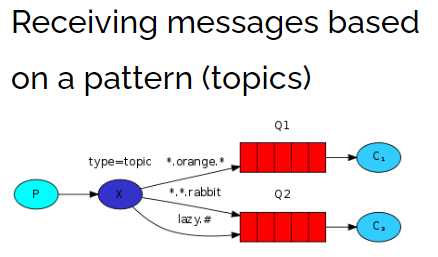
生产者创建Topic的exchange并且绑定到队列中,这次绑定可以通过*和#关键字,对指定RoutingKey内容,编写时注意格式 xxx.xxx.xxx 去别写。* -》代表xxx,# -》代表多个xxx.xxx,在发送消息时,指定具体的RoutingKey到底时什么
package com.liusx.topic;
import com.liusx.config.RabbitMQClient;
import com.rabbitmq.client.BuiltinExchangeType;
import com.rabbitmq.client.Channel;
import com.rabbitmq.client.Connection;
import org.junit.Test;
public class Publisher {
@Test
public void publish() throws Exception {
//1. 获取Connection
Connection connection = RabbitMQClient.getConnection();
//2. 创建Channel
Channel channel = connection.createChannel();
// 创建exchange绑定队列 topic-queue-1 topic-queue-2
// 动物的信息 <speed>.<color>.<what>
// *.red.* -> *占位符
// fast.# -> #通配符
// *.*.rabbit
channel.exchangeDeclare("topic-exchange", BuiltinExchangeType.TOPIC);
channel.queueBind("topic-queue-1","topic-exchange","*.red.*");
channel.queueBind("topic-queue-2","topic-exchange","fast.#");
channel.queueBind("topic-queue-2","topic-exchange","*.*.rabbit");
//3. 发布消息到exchange,同时指定路由的规则
channel.basicPublish("topic-exchange","fast.red.monkey",null,"红快猴子".getBytes());
channel.basicPublish("topic-exchange","slow.black.dog",null,"黑漫狗".getBytes());
channel.basicPublish("topic-exchange","fast.white.cat",null,"快白猫".getBytes());
System.out.println("生产者发布消息成功!");
//4. 释放资源
channel.close();
connection.close();
}
}
消费这还是与上一节一样,修改队列名称即可
//3. 声明队列-HelloWorld
channel.queueDeclare("topic-queue-1",true,false,false,null);
//4. 开启监听Queue,然后消费
channel.basicConsume("topic-queue-1",false,consumer);
--------------
//3. 声明队列-HelloWorld
channel.queueDeclare("topic-queue-2",true,false,false,null);
//4. 开启监听Queue,然后消费
channel.basicConsume("topic-queue-2",false,consumer);
RabbitMQ整合SpringBoot
5.1.SpringBoot整合RabbitMQ
1.创建SpringBoot工程
2.导入依赖
<dependency>
<groupId>org.springframework.boot</groupId>
<artifactId>spring-boot-starter-amqp</artifactId>
</dependency>
3.编写配置文件
spring:
rabbitmq:
host: 192.168.3.54
port: 5672
username: test
password: test
virtual-host: /test
4.声明exchange、queue,编写配置类RabbitMQConfig.java
package com.example.sprinbootrabbitmq.config;
import org.springframework.amqp.core.Binding;
import org.springframework.amqp.core.BindingBuilder;
import org.springframework.amqp.core.Queue;
import org.springframework.amqp.core.TopicExchange;
import org.springframework.context.annotation.Bean;
import org.springframework.context.annotation.Configuration;
@Configuration
public class RabbitMQConfig {
//1. 创建exchange - topic
//参数1:数据持久化
//参数2:读取后数据自动删除
@Bean
public TopicExchange getTopicExchange(){
return new TopicExchange("boot-topic-exchange", true, false);
}
//2. 创建queue
//参数1:queue - 指定队列的名称
//参数2:durable - 当前队列是否需要持久化(true)
//参数3:exclusive - 是否排外(conn.close() - 当前队列会被自动删除,当前队列只能被一个消费者消费)
//参数4:autoDelete - 如果这个队列没有消费者在消费,队列自动删除
//参数5:arguments - 指定当前队列的其他信息
@Bean
public Queue getQueue(){
return new Queue("boot-queue", true, false, false, null);
}
//3. 绑定在一起
@Bean
public Binding getBinding(TopicExchange topicExchange, Queue queue){
return BindingBuilder.bind(queue).to(topicExchange).with("*.red.*");
}
}
5.发布消息到RabbitMQ
package com.example.sprinbootrabbitmq;
import org.junit.jupiter.api.Test;
import org.springframework.amqp.rabbit.core.RabbitTemplate;
import org.springframework.beans.factory.annotation.Autowired;
import org.springframework.boot.test.context.SpringBootTest;
import java.io.IOException;
import java.util.UUID;
@SpringBootTest
class SprinbootRabbitmqApplicationTests {
@Autowired
private RabbitTemplate rabbitTemplate;
@Test
void contextLoads() throws IOException {
rabbitTemplate.convertAndSend("boot-topic-exchange","slow.red.dog","红色大狼狗!!",null);
System.in.read();
}
}
6.创建消费者监听消息
package com.example.sprinbootrabbitmq.listen;
import org.springframework.amqp.rabbit.annotation.RabbitListener;
import org.springframework.stereotype.Component;
import java.io.IOException;
@Component
public class Consumer {
@RabbitListener(queues = "boot-queue")
public void getMessage(Object message) throws IOException {
System.out.println("接收到消息;"+message);
}
}
5.2.手动Ack
1.增加配置文件配置
spring:
rabbitmq:
listener:
simple:
# auto:自动,manual:手动,none:不配置
acknowledge-mode: manual
2.手动 Ack 消费者代码
package com.example.sprinbootrabbitmq.listen;
import com.rabbitmq.client.Channel;
import org.springframework.amqp.core.Message;
import org.springframework.amqp.rabbit.annotation.RabbitListener;
import org.springframework.stereotype.Component;
import java.io.IOException;
@Component
public class Consumer {
@RabbitListener(queues = "boot-queue")
public void getMessage(String msg, Channel channel, Message message) throws IOException {
System.out.println("接收到消息;"+msg);
int i = 1/0;
channel.basicAck(message.getMessageProperties().getDeliveryTag(),false);
}
}
RabbitMQ其他操作
6.1.消息的可靠性
6.1.1.Confirm
RabbitMQ的事务:事务可以保证消息100%传递,可以通过事务的回滚去记录日志,后面定时再次发送当前消息。事务的操作,效率太低,加了事务操作后,比平时的操作效率至少要慢100倍。
RabbitMQ除了事务,还提供了 Confirm的确认机制,这个效率比事务高很多。
1.普通Confirm方式
package com.liusx.confirm;
import com.liusx.config.RabbitMQClient;
import com.rabbitmq.client.Channel;
import com.rabbitmq.client.Connection;
import org.junit.Test;
public class Publisher {
@Test
public void publish() throws Exception {
//1. 获取Connection
Connection connection = RabbitMQClient.getConnection();
//2. 创建Channel
Channel channel = connection.createChannel();
//3.1 开启confirm
channel.confirmSelect();
//3.2 发送消息
channel.basicPublish("","HelloWorld",null,"Hello-World".getBytes());
if(channel.waitForConfirms()){
System.out.println("生产者发布消息成功!");
}else {
System.out.println("生产者发布消息失败!");
}
//4. 释放资源
channel.close();
connection.close();
}
}
2.批量Confirm方式
//3.1 开启confirm
channel.confirmSelect();
//3.2 批量发送消息
for (int i = 0; i < 1000; i++) {
channel.basicPublish("","HelloWorld",null,("Hello-World"+i).getBytes());
}
//3.3 确定批量操作是否成功
// 当你发送的全部消息,有一个失败时,就直接全部失败 并抛出IOException
channel.waitForConfirmsOrDie();
3.异步Confirm方式
//3.1 开启confirm
channel.confirmSelect();
//3.2 批量发送消息
for (int i = 0; i < 1000; i++) {
channel.basicPublish("","HelloWorld",null,("Hello-World"+i).getBytes());
}
//3.3 开启异步回调
channel.addConfirmListener(new ConfirmListener() {
@Override
public void handleAck(long deliveryTag, boolean multiple) throws IOException {
System.out.println("消息发送成功,标识:" + deliveryTag + ",是否是批量" + multiple);
}
@Override
public void handleNack(long deliveryTag, boolean multiple) throws IOException {
System.out.println("消息发送失败,标识:" + deliveryTag + ",是否是批量" + multiple);
}
});
6.1.2.Return
Confirm只能保证消息到达 exchange,无法保证消息可以被 exchange分发到指定 queue。
而且 exchange是不能持久化消息的,queue是可以持久化消息。
采用 Return机制来监听消息是否从 exchange送到了指定的 queue中
开启Return机制,并在发送消息时,指定mandatory为true
@Test
public void publishReturn() throws Exception {
//1. 获取Connection
Connection connection = RabbitMQClient.getConnection();
//2. 创建Channel
Channel channel = connection.createChannel();
// 开启return机制
channel.addReturnListener(new ReturnListener() {
@Override
public void handleReturn(int replyCode, String replyText, String exchange, String routingKey, AMQP.BasicProperties properties, byte[] body) throws IOException {
// 当消息没有送达到queue时,才会执行。
System.out.println(new String(body,"UTF-8") + "没有送达到Queue中!!");
}
});
//3.1 开启confirm
channel.confirmSelect();
//3.2 发送消息
// 参数3:开启return
channel.basicPublish("","XXX",true,null,"Hello-World".getBytes());
if(channel.waitForConfirms()){
System.out.println("生产者发布消息到exchange成功!");
}else {
System.out.println("生产者发布消息exchange失败!");
}
//4. 释放资源
channel.close();
connection.close();
}
输出:
Hello-World没有送达到Queue中!!
生产者发布消息到exchange成功!
6.2.3.SringBoot实现
1.编写配置文件
spring:
rabbitmq:
publisher-confirm-type: simple
publisher-returns: true
2.编写代码
package com.example.sprinbootrabbitmq.config;
import org.springframework.amqp.core.Message;
import org.springframework.amqp.rabbit.connection.CorrelationData;
import org.springframework.amqp.rabbit.core.RabbitTemplate;
import org.springframework.beans.factory.annotation.Autowired;
import org.springframework.stereotype.Component;
import javax.annotation.PostConstruct;
@Component
public class PublisherConfirmAndReturnConfig implements RabbitTemplate.ConfirmCallback ,RabbitTemplate.ReturnCallback {
@Autowired
private RabbitTemplate rabbitTemplate;
@PostConstruct // init-method
public void initMethod(){
rabbitTemplate.setConfirmCallback(this);
rabbitTemplate.setReturnCallback(this);
}
@Override
public void confirm(CorrelationData correlationData, boolean ack, String cause) {
if(ack){
System.out.println("消息已经送达到Exchange");
}else{
System.out.println("消息没有送达到Exchange");
}
}
@Override
public void returnedMessage(Message message, int replyCode, String replyText, String exchange, String routingKey) {
System.out.println("消息没有送达到Queue");
}
}
6.2.消息重复消费-Java版
重复消费消息,会对非幂等操作造成问题
重复消费消息的原因是,消费者没有给RabbitMQ一个Ack
为了解决消息重复消费的问题,可以采用 Redis,在消费者消费消息之前,现将消息的j放到 Redis中,
id-0(正在执行业务)
id-1(执行业务成功)
如果ack失败,在RabbitMQ将消息交给其他的消费者时,先执行 setnx,如果key已经存在,获取他的值,如果是0,当前消费者就什么都不做,如果是1,直接ack。
极端情况:第一个消费者在执行业务时,出现了死锁,在setnx的基础上,再给key设置一个生存时间。
先增加依赖
<dependency>
<groupId>redis.clients</groupId>
<artifactId>jedis</artifactId>
<version>2.9.0</version>
</dependency>
生产者,发送消息时,指定messageId
package com.liusx.repeat;
import com.liusx.config.RabbitMQClient;
import com.rabbitmq.client.AMQP;
import com.rabbitmq.client.Channel;
import com.rabbitmq.client.Connection;
import org.junit.Test;
import java.util.UUID;
public class Pulisher {
@Test
public void publish() throws Exception {
//1. 获取Connection
Connection connection = RabbitMQClient.getConnection();
//2. 创建Channel
Channel channel = connection.createChannel();
//3. 发送消息(顺便生成消息ID发送过去)
AMQP.BasicProperties properties = new AMQP.BasicProperties().builder()
.deliveryMode(1) // 指定消息是否需要持久化:1 - 需要持久化 2 - 不需要持久化
.messageId(UUID.randomUUID().toString())
.build();
String msg = "Hello-World";
channel.basicPublish("","HelloWorld",true,properties,msg.getBytes());
}
}
消费者,在消费消息时,根据具体业务逻辑去操作redis
package com.liusx.repeat;
import com.liusx.config.RabbitMQClient;
import com.rabbitmq.client.*;
import org.junit.Test;
import redis.clients.jedis.Jedis;
import java.io.IOException;
public class Consumer {
@Test
public void consume() throws Exception {
//1. 获取连接对象
Connection connection = RabbitMQClient.getConnection();
//2. 创建channel
Channel channel = connection.createChannel();
//3. 声明队列-HelloWorld
channel.queueDeclare("HelloWorld",true,false,false,null);
//4. 开启监听Queue
DefaultConsumer consume = new DefaultConsumer(channel){
@Override
public void handleDelivery(String consumerTag, Envelope envelope, AMQP.BasicProperties properties, byte[] body) throws IOException {
Jedis jedis = new Jedis("192.168.3.54",6379);
String messageId = properties.getMessageId();
//1. setnx到Redis中,默认指定value-0
String result = jedis.set(messageId, "0", "NX", "EX", 10);
if(result != null && result.equalsIgnoreCase("OK")) {
System.out.println("接收到消息:" + new String(body, "UTF-8"));
//2. 消费成功,set messageId 1
jedis.set(messageId,"1");
channel.basicAck(envelope.getDeliveryTag(),false);
}else {
//3. 如果1中的setnx失败,获取key对应的value,如果是0,return,如果是1
String s = jedis.get(messageId);
if("1".equalsIgnoreCase(s)){
channel.basicAck(envelope.getDeliveryTag(),false);
}
}
}
};
//参数:queue - 指定消费哪个队列、autoAck - 指定是否自动ACK、consumer - 指定消费回调
channel.basicConsume("HelloWorld",false,consume);
System.out.println("消费者开始监听队列!");
System.in.read();
//5. 释放资源
channel.close();
connection.close();
}
}
6.3.消息重复消费-SpringBoot
1.导入依赖
<dependency>
<groupId>org.springframework.boot</groupId>
<artifactId>spring-boot-starter-data-redis</artifactId>
</dependency>
2.编写配置文件
spring:
redis:
host: 192.168.3.54
port: 6379
3.修改生产者
package com.example.sprinbootrabbitmq;
import org.junit.jupiter.api.Test;
import org.springframework.amqp.rabbit.connection.CorrelationData;
import org.springframework.amqp.rabbit.core.RabbitTemplate;
import org.springframework.beans.factory.annotation.Autowired;
import org.springframework.boot.test.context.SpringBootTest;
import java.io.IOException;
import java.util.UUID;
@SpringBootTest
class SprinbootRabbitmqApplicationTests {
@Autowired
private RabbitTemplate rabbitTemplate;
@Test
void contextLoads() throws IOException {
CorrelationData messageId = new CorrelationData(UUID.randomUUID().toString());
rabbitTemplate.convertAndSend("boot-topic-exchange","slow.red.dog","红色大狼狗!!",messageId);
System.in.read();
}
}
4.修改消费者
package com.example.sprinbootrabbitmq.listen;
import com.rabbitmq.client.Channel;
import org.springframework.amqp.core.Message;
import org.springframework.amqp.rabbit.annotation.RabbitListener;
import org.springframework.beans.factory.annotation.Autowired;
import org.springframework.data.redis.core.StringRedisTemplate;
import org.springframework.stereotype.Component;
import java.io.IOException;
import java.util.concurrent.TimeUnit;
@Component
public class Consumer {
@Autowired
private StringRedisTemplate redisTemplate;
@RabbitListener(queues = "boot-queue")
public void getMessage(String msg, Channel channel, Message message) throws IOException {
//0. 获取MessageId
String messageId = message.getMessageProperties().getHeader("spring_returned_message_correlation");
//1. 设置key到Redis
if(redisTemplate.opsForValue().setIfAbsent(messageId,"0",10, TimeUnit.SECONDS)) {
//2. 消费消息
System.out.println("接收到消息:" + msg);
//3. 设置key的value为1
redisTemplate.opsForValue().set(messageId,"1",10,TimeUnit.SECONDS);
//4. 手动ack
channel.basicAck(message.getMessageProperties().getDeliveryTag(),false);
}else {
//5. 获取Redis中的value即可 如果是1,手动ack
if("1".equalsIgnoreCase(redisTemplate.opsForValue().get(messageId))){
channel.basicAck(message.getMessageProperties().getDeliveryTag(),false);
}
}
}
}
转载请注明来源,欢迎对文章中的引用来源进行考证,欢迎指出任何有错误或不够清晰的表达。可以在下面评论区评论,也可以邮件至 8629303@qq.com

